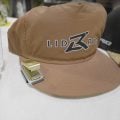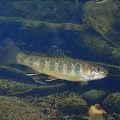Fly Tying: How to Tie a Sulphur Comparadun
Producer: Tim Flagler
If I could only have one fly to use during a sulphur hatch, it would likely be this one – a Sulphur Comparadun. It’s just a bit more subtle than a Catskill-style dry or a parachute, and the trout seem to appreciate this. Comparaduns however can be somewhat demanding to tie. Practice is definitely required.
For a hook, I’m going to start with a Lightning Strike DF1 in size 16. Begin by getting the hook firmly secured in the jaws of your tying vise.
For thread, I’ve loaded a bobbin with a spool of yellow UTC 70 Denier. Get your thread started on the hook shank leaving an eye-length space behind the eye and take a few wraps rearward before snipping off the tag. Do leave the tag a little longer than normal and, rather than discarding it, tuck it away in a safe place for later use. Take thread wraps forward, leaving your thread an eye-length-and-a-half behind the hook eye.
Volumes can be written about the correct deer hair to use for a Comparadun. My hands down favorite is the stuff labeled “short/fine” from Wapsi. It’s the right length, texture, hollowness and has only the smallest amount of black at the tips of the hair. For the way I tie Comparaduns, I’ve found no better. With sulphurs, I like the lighter, bleached stuff. Snip a half-a-pencil diameter clump free from the hide and strip or comb out the fuzzy stuff and the shorter hairs. The cleaner you can get it, the better. Place the clump tips first into a small stacker and give it a very thorough stacking to get all the tips aligned. With the tips pointing to the right, remove them with the fingers of your right hand and then pass the clump to your left, like so.
Carefully, and I mean really carefully, measure to form a wing a hook shank in length and then transfer that measurement forward to the location of your tying thread. Take two loose collecting wraps then pull the thread tight as you squeeze the fingers of your left hand. The deer hair should compress and flare significantly. While maintaining pressure, take a few more tight wraps rearward to firmly bind the hair to the shank. Keep your grip on the butt ends of the deer hair and lift them up slightly. This will allow you to reach in with your tying scissors and snip them off at a shallow angle. You can then take wraps of tying thread to mildly cover up the butt ends and produce a nice ramp down to the hook shank. Pull the wing back to ensure that there’s at least a full eye-length space behind the eye. Continue taking thread wraps to bind the butt ends down and leave your tying thread at about the hook point.
Medium dun-colored micro-fibbets or mayfly tails are used to form the tail of the fly. Separate two from the rest and, while keeping their tips aligned, snip them free. With the tips pointing rearward on the fly, lay the two fibers against the near side of the hook and let thread torque carry them to the top. After a couple of wraps, you can adjust the length of the tails if necessary. They should be about a full hook in length. When you’re satisfied with the look of the tails, snip the excess butt ends off close. Take a few more thread wraps forward then push the tails up and use your thumbnail to help separate them. Once you’ve established a little separation, preen the tails outward to accentuate it.
Now, get hold of that tag end of thread you snipped off earlier. Loop it around the hook bend and double it over. Then, pull the loop around the bend all the way up to between the two tails. Pull on the loop to splay the tails until they’re about 90 degrees apart then take thread wraps rearward. This should lock the tails in position. Lift the excess thread tag up to vertical and snip it off close. Check to make sure your tails are splayed correctly.
Even with the tail angle well established, I like to add just the smallest drop of UV cure resin, here, Solarez Bone Dry, to the intersection of the tails and down onto the hook shank. Once I’ve picked up my UV torch and given the area a brief shot of UV light, the tails will be permanently locked in position. This isn’t essential but it really works.
Pale yellow Super Fine dubbing is used to create both the abdomen and thorax of the fly. We’ll start with the abdomen first – you’ll need a fairly ample clump. Pull down on your bobbin to expose 4-5” of tying thread then take small amounts of dubbing from the clump so the fibers are roughly aligned with your tying thread. This will allow you to create a very thin dubbing noodle. Once you have a noodle about 4” in length, start taking wraps with it so the dubbing begins right at the base of the tail. Continue taking touching wraps forward with the noodle to create a slender almost segmented body on the fly and cover up those nasty deer hair butts. Then, pull the deer hair back and start taking wraps to build up a dam in front of it. You may need to go back to your dubbing packet to make another thin but shorter noodle on your tying thread. Use this to further pin the wing back and sandwich it between the abdomen and the thorax. Continue taking wraps until you have bare thread at the back edge of the hook eye. Once there, do a 4 – 5 turn whip finish, seat the knot well and snip or cut your tying thread free. You may need to do a little preening with the deer hair so it fans out over the top 180 degrees.
Like I said, the Sulphur Comparadun is a great pattern but does require a good bit of practice to get consistent results. Wing length and orientation are of paramount importance.
Fly Tying: How to Tie a Spey Zonker
Fly Tying: How to Tie a Western Coachman











